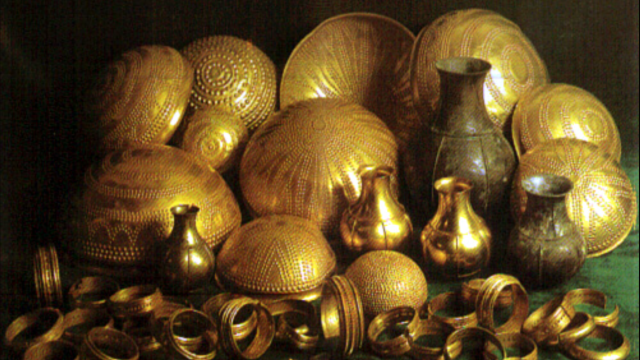A bracelet and possible sword pommel found in a 3,000-year-old treasure hoard were forged from meteoritic iron, according to a team of researchers that recently studied the pieces. In other words, yes: some Bronze Age Iberian was rocking space jewelry and wielding a space weapon.
The iron was discovered 50 years ago, when the archaeologist José María Soler found the treasure hoard buried under a boulevard in Villena, Spain. The trove consisted of 66 pieces of gold and silver bowls, bracelets, bottles and ornaments, as well as a couple of pieces made of iron.
The hoard is now known as the Treasure of Villena. But here’s the rub: the treasure was hidden 3,000 years ago, before widespread knowledge of iron metallurgy.
The team’s research, published in Trabajos de Prehistoria, posits that the iron pieces may have been made in the Late Bronze Age—before humans began working with terrestrial iron. The bracelet is made entirely of iron, while the hemispheric object interpreted as a sword pommel is iron covered in a gold four-pointed star design, according to El País.
To determine the origins of the iron in the hoard, the team sampled the pieces and tested the iron’s nickel composition, which tends to be higher in iron from space than terrestrial iron. The team also looked for elements that turn up in meteoritic iron, like cobalt, using mass spectrometry. The team found there was a high probability the hoard’s iron was meteoritic in origin.
Before the rise of iron metallurgy, humans used iron from fallen meteorites to make precious items. The most famous example of this is the pharaoh Tutankhamun’s meteoritic dagger, a small blade found in the tomb of the “boy king.”
An analysis by a different team published in February 2022 suggested that Tutankhamun’s blade was made through low-temperature forging, but not in Egypt. One of the 3,400-year-old Amarna Letters mentions an iron dagger given to Tut’s grandfather, the pharaoh Amenhotep III, by the king of Mitanni, a region of Anatolia. It’s possible the famous blade was a family heirloom.
But pharaonic Egypt kept fastidious records, at least compared to the group that forged the Treasure of Villena. According to El País, study co-author Ignacio Montero Ruiz, a researcher at the CSIC Institute of History, said that the makers of the treasure and where they got the iron is still unclear.
Given the 2022 explanation for Tut’s iron, it’s possible that the materials used to make the Villena hoard weren’t from Spain. More analysis may clarify the remarkable trove’s origins, and perhaps even the wearer of the ancient luxury goods.
